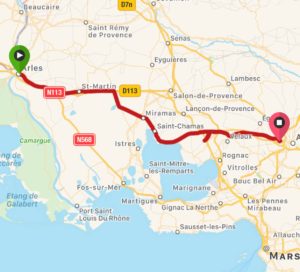
Arles to Aix-en-Provence – 88km
(D453, N1453, D113, D5, D10, D64, D17)
May 1 in Arles marks the Festival of the Gardians and Election of the Queen of Arles, an event that celebrates the traditions of the herdsmen who have followed the bulls and horses in the Camargue. A candidate for the 3-year tenure as Queen of Arles must be knowledgeable in Provençal history, literature, architecture, arts, traditions and language. We delayed our departure to watch the procession of the Gardians and their partners riding on horseback past the Roman arena on the way to Mass at the Cathedral. Later in the day, equestrian games would be held in the arena, organised by the Brotherhood of Guardians (for photos see this page).
The city of Arles, which we had visited earlier in the week by car, is the site of extensive Roman ruins, including a largely intact coliseum and partly-preserved Roman baths. It is also where Vincent Van Gogh spent 15 months, during which time he produced over 180 canvasses, which include some of his best-known works. The Fondation Vincent Van Gogh was currently exhibiting 6 of his paintings, among which was his self-portrait. An accompanying exhibition of many of the works of the American painter Alice Neel was very interesting.
The proprietor of our B&B (Villa M – highly recommended) told us to look out for a new building going up, designed by Frank Gehry. It will house a cultural centre supported by the Luma Foundation. The construction is impressive, even now.
Approaching Maramas, we cycled alongside a vast intact prison camp of rows of essentially windowless huts. We read later that this was used by the US Army to house German prisoners of war from 1944-45. On the opposite side of the highway, a race track, the sight of the French Grand Prix in 1926, is now used by BMW to test cars.
At a pizza restaurant in Maramas, one of the few places open for lunch on the holiday, our journey generated a lot of interest amongst the patrons. The Vancouver license plates prompt questions! As we got further away from the marshes and rice fields of the Camargue, the land became drier, with pine forests, olive trees and vineyards beneath limestone hills with strange outcroppings. We stopped to admire the Pont Flavien, built in 10-12BC. It has been repaired many times, but remains a remarkable sight.
We arrived late in Aix-en-Provence, partly as a result of mistakes in finding our route and having to backtrack. We agreed that we really do need to take more control of our route-planning and be less ruled by Garmin and Google!




